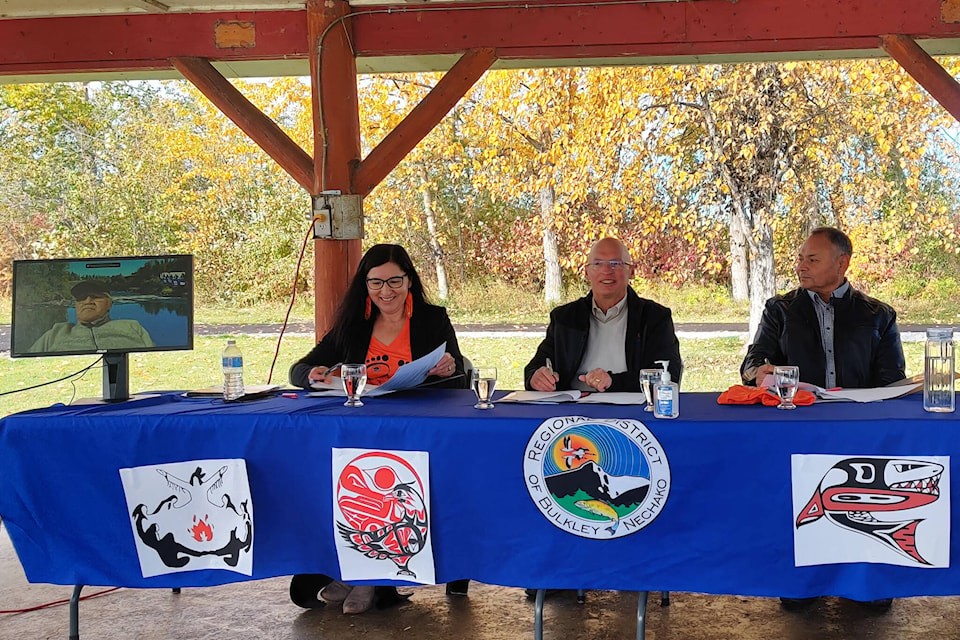On the eve of the first National Day for Truth and Reconciliation, Nechako First Nations and the Regional District of Bulkley-Nechako (RDBN) signed a landmark memorandum of understanding to work together to restore the health of the Nechako River.
Chief Priscilla Mueller of Saik’uz First Nation said the Nechako First Nations have been meeting with the regional district for over a year to discuss how they can find ways to help improve the health of the river as it not only impacts the First Nation communities but non-indigenous communities including Vanderhoof as well.
READ MORE: RDBN calls on Canada, B.C. and Rio Tinto to restore the natural flow of the Nechako River
“The river right now is not healthy,” she said Wednesday, Sept. 29. “So we sat down and began talks on how we are going to do this. I don’t think its ever too late for us to start working together as a group.”
Through the MOU, Nechako First Nations which include Saik’uz, Stellat’en and Nadleh Whut’en and the RDBN have agreed that they need to work together to restore the health of the river, its affected tributaries and its fish population, with a particular focus on sturgeon and salmon populations.
It also calls for more natural flows in the Nechako River, new stewardship projects, and a new governance regime to replace the one established in 1987 which excludes Nechako First Nations and the Regional District and is “widely understood to have contributed to the decline of the Nechako River,” as stated in the news release.
Gerry Thiessen, RDBN chairperson and Mayor of Vanderhoof said,”Local First Nations and non-indigenous communities alike have suffered from the impacts of the Nechako water management regime which has prioritized energy production over a healthy river and fish populations. The people of our region — those who use and depend on the river — deserve a healthy Nechako and a legitimate seat at the table when it comes to water management. We can achieve that goal by continuing to work together collaboratively.”
The Nechako River was one of the largest tributaries of the Fraser River. Headwaters of the Nechako River lie within the Nechako Reservoir which was created by the construction of Kenney Dam to provide hydroelectric power to an aluminium smelter in Kitimat. Completion of this dam in the 1950s has altered the flow patterns of the Nechako River.
Most of the water that would have otherwise flowed down the Nechako has been diverted west through the mountains to produce hydroelectric power for the smelter. From 1985-2018, the average flow in the Upper Nechako River is estimated to have been just 36 percent of the natural flow prior to the construction of the dam, stated a Sept. 29 news release.
Due to the reduction in natural flow, the river’s fish populations and habitat were impacted. The Nechako white sturgeon is on the precipice of extinction, and the lack of spring freshet and the dewatering of floodplain and side channels are impairing chinook salmon productivity and recruitment. Migrating sockeye salmon in the Nechako encounter artificially warm temperatures which affect their pre-spawn mortality, stated the news release.
“Since time immemorial, the Stellat’en people have lived beside and on the Nechako river. The river was our economic and spiritual lifeblood. It was taken away from us and converted into an industrial canal without any consultation or compensation,” said Robert Mitchell, elected chief of Stellat’en First Nation.
“We need what was lost to be returned. And when it is - when the river is brought back to health - everyone in the region will stand to benefit.”
In 2011, Saik’uz and Stellat’en started an action against Rio Tinto Alcan in the Supreme Court of British Columbia to obtain a court order to restore the natural flow to the river. The trial commenced in October 2019 and was completed this past summer. A decision is yet to be made.
READ MORE: Saik’uz and Stellat’en First Nations court battle against RioTinto Alcan
In a statement to the Express on Sept. 30, spokesperson for Rio Tinto Alcan said,”“Rio Tinto actively supports efforts to improve the health of the Nechako River and is working with the Nechako First Nations, other First Nations and a wide variety of stakeholders to contribute to these efforts.”
“We believe that governance of the flows on the Nechako River should be an inclusive process that evolves over time. Reservoir management is a complex matter where a number of interests must be carefully considered and balanced. For the past three years we have been working with a variety of parties at the Water Engagement Initiative (WEI) for the benefit of the Nechako river. We are committed to working with the Nechako First Nations, other First Nations, government and stakeholders to review all aspects of the Nechako Reservoir management process.”
Aman Parhar
Editor - Vanderhoof Omineca Express, Caledonia Courier
aman.parhar@ominecaexpress.com
Like us on Facebook and follow us on Twitter
